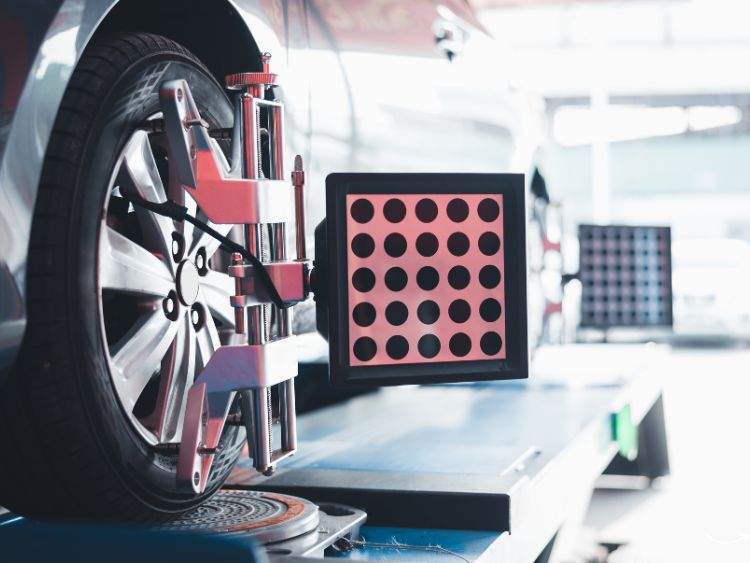When it comes to maintaining your BMW, wheel alignment is often overlooked yet crucial. Proper wheel alignment ensures your car drives straight, improves fuel efficiency, and extends tire life. In this comprehensive guide, we’ll dive into the ins and outs of BMW wheel alignment, covering everything you need to know to keep your ride smooth and your vehicle in top condition.
What is Wheel Alignment?
Wheel alignment refers to the adjustment of your vehicle’s suspension, the system that connects a vehicle to its wheels. It’s not about adjusting the tires or wheels themselves. The key components of alignment are the camber, caster, and toe, each playing a vital role in how your BMW handles and wears its tires.
Camber
- Positive Camber: When the tops of the tires tilt outward.
- Negative Camber: When the tops of the tires tilt inward.
Caster
- Positive Caster: The steering axis tilts towards the driver.
- Negative Caster: The steering axis tilts towards the front of the car.
Toe
- Toe-In: Front of the tires are closer together than the rear.
- Toe-Out: Front of the tires are further apart than the rear.
Why BMW Wheel Alignment is Important
Improved Handling
A correctly aligned BMW ensures that all four wheels are working together in harmony. This synchronization is essential for accurate handling and steering response.
Enhanced Fuel Efficiency
Misaligned wheels create uneven tire drag, making the engine work harder and consume more fuel. Proper alignment reduces this drag, improving your BMW’s fuel efficiency.
Prolonged Tire Life
When your wheels are out of alignment, tires wear unevenly and more quickly. Regular alignments help extend the life of your tires, saving you money in the long run.
Safety
Proper alignment ensures your BMW drives straight and true, reducing the risk of accidents caused by pulling or drifting.
How to Know if Your BMW Needs Wheel Alignment
Uneven Tire Wear
If you notice that one side of your tires is wearing faster than the other, it’s a sign of misalignment.
Car Pulling to One Side
When your car drifts to one side while driving straight, it indicates that your wheels may be out of alignment.
Steering Wheel Off-Center
If your steering wheel is not centered when driving straight, it’s a good indicator that your alignment is off.
Vibration in the Steering Wheel
Vibration or shaking in the steering wheel can also be a sign of alignment issues.
DIY vs. Professional Wheel Alignment
DIY Wheel Alignment
While some enthusiasts prefer a DIY approach, it’s crucial to have the right tools and knowledge. A slight error can lead to significant issues.
Professional Wheel Alignment
A professional service ensures precise alignment using specialized equipment. Certified technicians can accurately adjust the camber, caster, and toe according to BMW’s specifications.
Steps in Professional BMW Wheel Alignment
- Inspection: Technicians start by inspecting the tires and suspension components.
- Measurement: Using an alignment machine, they measure the current alignment angles.
- Adjustment: Based on the measurements, they adjust the camber, caster, and toe.
- Test Drive: Finally, they test drive the vehicle to ensure everything is aligned correctly.
FAQs about BMW Wheel Alignment
How often should I get my BMW’s wheels aligned?
It’s recommended to check your alignment every 6,000 miles or whenever you get new tires.
Can I drive with a misaligned wheel?
Driving with misaligned wheels can lead to uneven tire wear, poor handling, and decreased fuel efficiency. It’s best to address alignment issues promptly.
How long does a wheel alignment take?
A professional wheel alignment typically takes about an hour.
Is wheel alignment covered under warranty?
Wheel alignment is generally considered a maintenance service and may not be covered under warranty. However, some extended warranty plans might include it.
How much does a BMW wheel alignment cost?
The cost can vary, but it typically ranges between $100 to $200, depending on your location and the complexity of the alignment.
Conclusion
Keeping your BMW’s wheels aligned is crucial for optimal performance, safety, and tire longevity. Regular checks and professional alignments ensure your vehicle handles correctly and runs efficiently. Don’t overlook this essential maintenance task—your BMW and your wallet will thank you!
Authoritative Links
- BMW USA Service: https://www.bmwusa.com/service-maintenance/wheel-alignment.html
- Tire Rack: https://www.tirerack.com/tires/tiretech/techpage.jsp?techid=4
- Car and Driver: https://www.caranddriver.com/research/a31875104/wheel-alignment-cost/
By following these guidelines, you can maintain your BMW’s wheel alignment and enjoy a smooth, safe ride. Regular maintenance is key to keeping your vehicle in top shape, ensuring that every drive is as enjoyable as the first.





